Integrating TPM, Lean, Agile, and Six Sigma in Manufacturing Systems
VerifiedAdded on 2019/12/17
|25
|5789
|226
Report
AI Summary
This report provides a comprehensive overview of Total Productive Maintenance (TPM), exploring its core concepts, history, and implementation strategies. It delves into various types of maintenance, including breakdown, preventive, predictive, corrective, and maintenance prevention, highlighting their significance in optimizing equipment efficiency and reducing downtime. The report further examines the integration of TPM with other methodologies such as Lean Manufacturing, Agile Manufacturing, and Six Sigma, demonstrating how these approaches collectively enhance manufacturing systems. It presents case studies illustrating the practical application of these tools, including Pareto charts, PFMEA, and SIPOC charts, to facilitate organized critical thinking and indicative abilities within manufacturing frameworks. The report also addresses the applicability of Lean and Agile Manufacturing in the services industry and concludes with a discussion of the key considerations for successful TPM implementation, emphasizing the importance of culture change, maintenance strategies, and operator involvement.
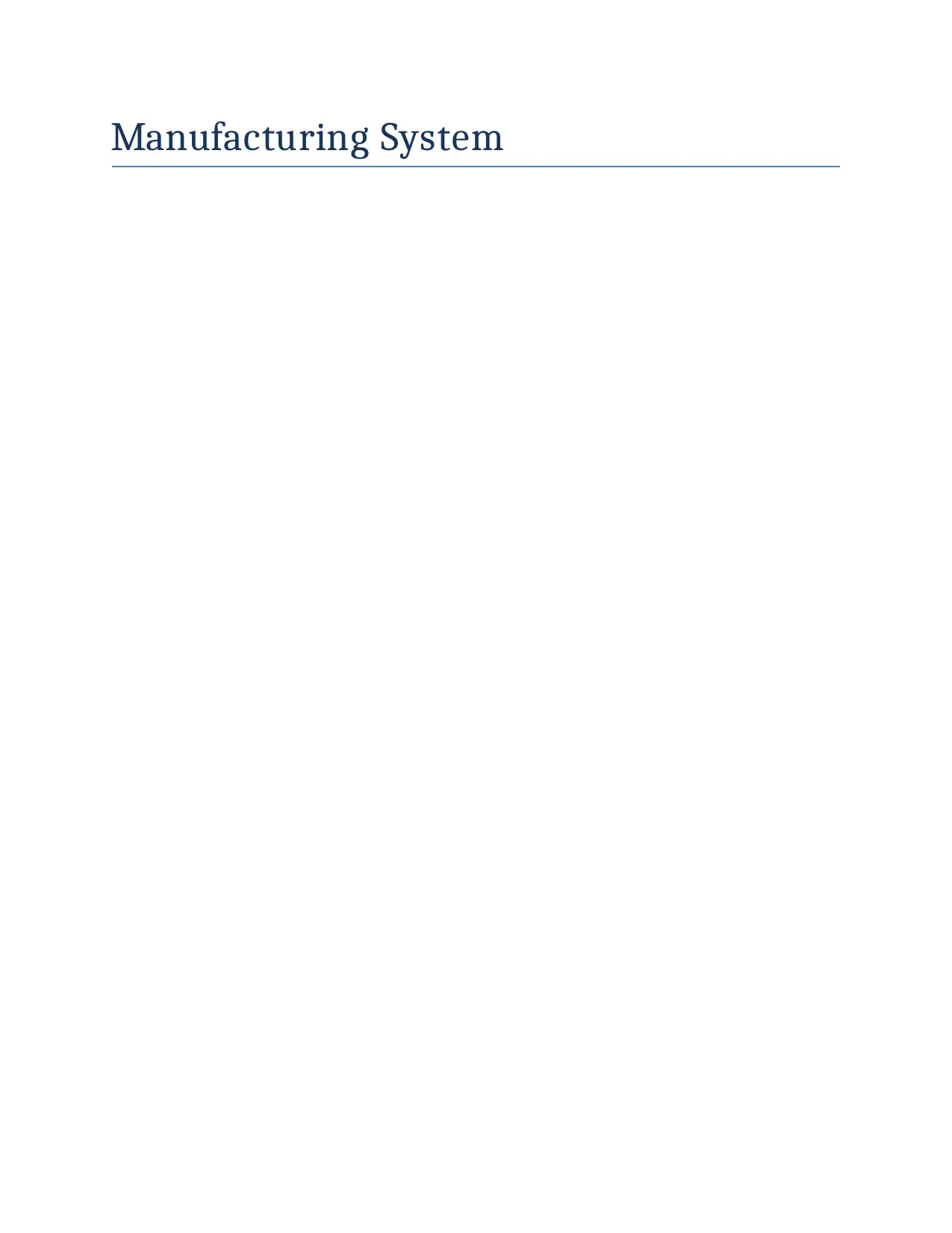
Manufacturing System
Paraphrase This Document
Need a fresh take? Get an instant paraphrase of this document with our AI Paraphraser
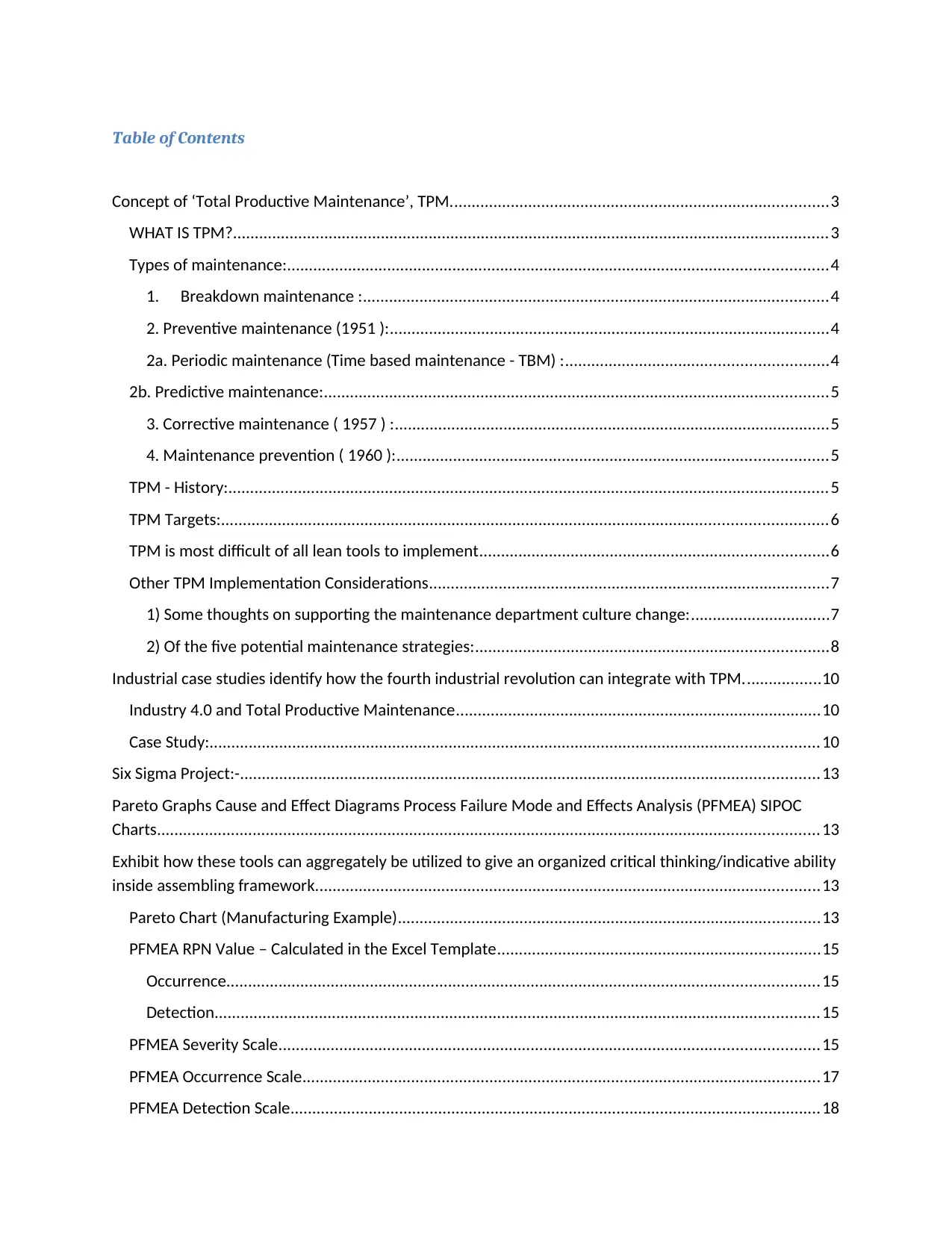
Table of Contents
Concept of ‘Total Productive Maintenance’, TPM.......................................................................................3
WHAT IS TPM?.........................................................................................................................................3
Types of maintenance:............................................................................................................................4
1. Breakdown maintenance :...........................................................................................................4
2. Preventive maintenance (1951 ):.....................................................................................................4
2a. Periodic maintenance (Time based maintenance - TBM) :............................................................4
2b. Predictive maintenance:....................................................................................................................5
3. Corrective maintenance ( 1957 ) :....................................................................................................5
4. Maintenance prevention ( 1960 ):...................................................................................................5
TPM - History:..........................................................................................................................................5
TPM Targets:...........................................................................................................................................6
TPM is most difficult of all lean tools to implement................................................................................6
Other TPM Implementation Considerations............................................................................................7
1) Some thoughts on supporting the maintenance department culture change:................................7
2) Of the five potential maintenance strategies:.................................................................................8
Industrial case studies identify how the fourth industrial revolution can integrate with TPM..................10
Industry 4.0 and Total Productive Maintenance....................................................................................10
Case Study:............................................................................................................................................10
Six Sigma Project:-.....................................................................................................................................13
Pareto Graphs Cause and Effect Diagrams Process Failure Mode and Effects Analysis (PFMEA) SIPOC
Charts........................................................................................................................................................13
Exhibit how these tools can aggregately be utilized to give an organized critical thinking/indicative ability
inside assembling framework....................................................................................................................13
Pareto Chart (Manufacturing Example).................................................................................................13
PFMEA RPN Value – Calculated in the Excel Template..........................................................................15
Occurrence........................................................................................................................................15
Detection...........................................................................................................................................15
PFMEA Severity Scale............................................................................................................................15
PFMEA Occurrence Scale.......................................................................................................................17
PFMEA Detection Scale..........................................................................................................................18
Concept of ‘Total Productive Maintenance’, TPM.......................................................................................3
WHAT IS TPM?.........................................................................................................................................3
Types of maintenance:............................................................................................................................4
1. Breakdown maintenance :...........................................................................................................4
2. Preventive maintenance (1951 ):.....................................................................................................4
2a. Periodic maintenance (Time based maintenance - TBM) :............................................................4
2b. Predictive maintenance:....................................................................................................................5
3. Corrective maintenance ( 1957 ) :....................................................................................................5
4. Maintenance prevention ( 1960 ):...................................................................................................5
TPM - History:..........................................................................................................................................5
TPM Targets:...........................................................................................................................................6
TPM is most difficult of all lean tools to implement................................................................................6
Other TPM Implementation Considerations............................................................................................7
1) Some thoughts on supporting the maintenance department culture change:................................7
2) Of the five potential maintenance strategies:.................................................................................8
Industrial case studies identify how the fourth industrial revolution can integrate with TPM..................10
Industry 4.0 and Total Productive Maintenance....................................................................................10
Case Study:............................................................................................................................................10
Six Sigma Project:-.....................................................................................................................................13
Pareto Graphs Cause and Effect Diagrams Process Failure Mode and Effects Analysis (PFMEA) SIPOC
Charts........................................................................................................................................................13
Exhibit how these tools can aggregately be utilized to give an organized critical thinking/indicative ability
inside assembling framework....................................................................................................................13
Pareto Chart (Manufacturing Example).................................................................................................13
PFMEA RPN Value – Calculated in the Excel Template..........................................................................15
Occurrence........................................................................................................................................15
Detection...........................................................................................................................................15
PFMEA Severity Scale............................................................................................................................15
PFMEA Occurrence Scale.......................................................................................................................17
PFMEA Detection Scale..........................................................................................................................18
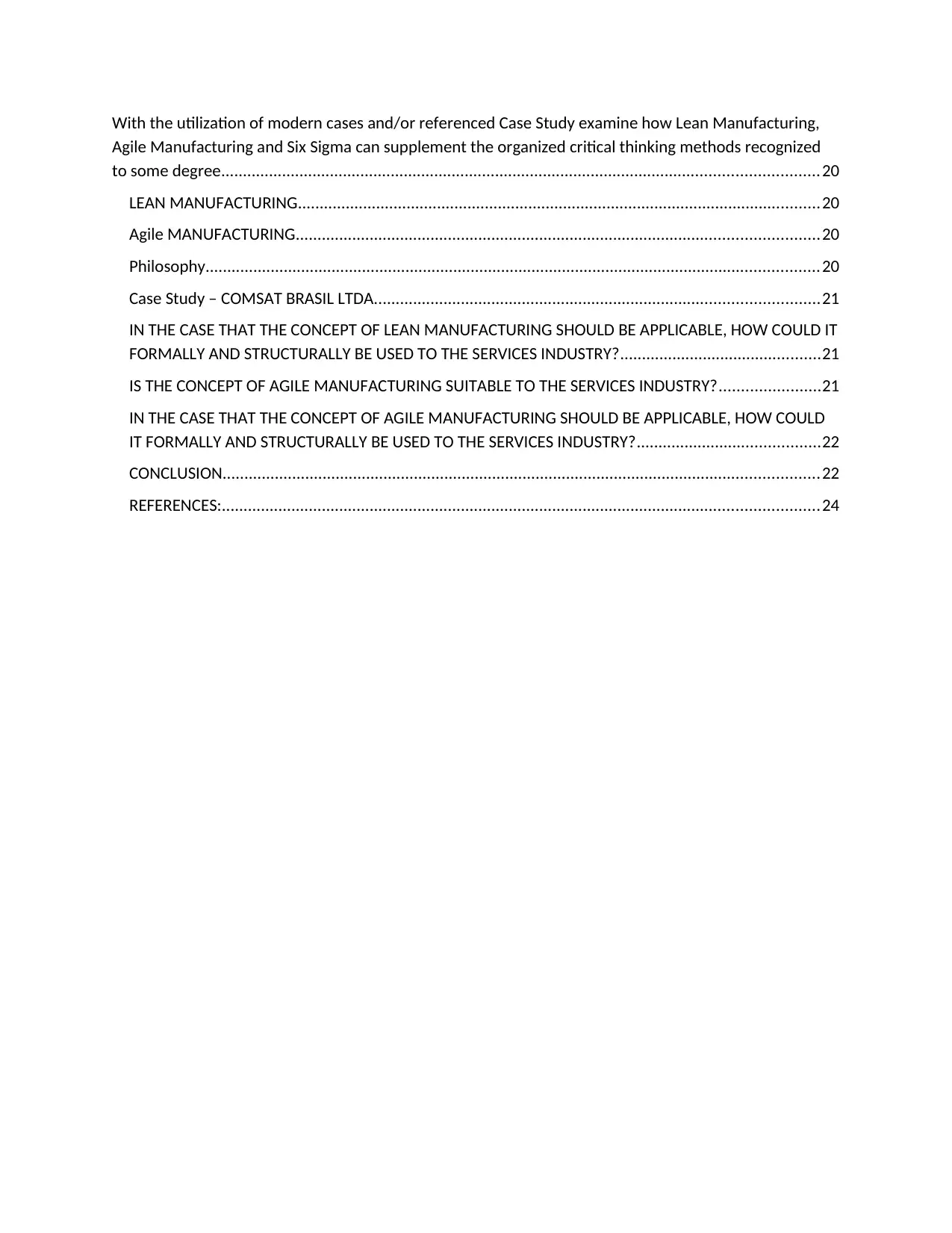
With the utilization of modern cases and/or referenced Case Study examine how Lean Manufacturing,
Agile Manufacturing and Six Sigma can supplement the organized critical thinking methods recognized
to some degree.........................................................................................................................................20
LEAN MANUFACTURING........................................................................................................................20
Agile MANUFACTURING........................................................................................................................20
Philosophy.............................................................................................................................................20
Case Study – COMSAT BRASIL LTDA......................................................................................................21
IN THE CASE THAT THE CONCEPT OF LEAN MANUFACTURING SHOULD BE APPLICABLE, HOW COULD IT
FORMALLY AND STRUCTURALLY BE USED TO THE SERVICES INDUSTRY?..............................................21
IS THE CONCEPT OF AGILE MANUFACTURING SUITABLE TO THE SERVICES INDUSTRY?.......................21
IN THE CASE THAT THE CONCEPT OF AGILE MANUFACTURING SHOULD BE APPLICABLE, HOW COULD
IT FORMALLY AND STRUCTURALLY BE USED TO THE SERVICES INDUSTRY?..........................................22
CONCLUSION.........................................................................................................................................22
REFERENCES:.........................................................................................................................................24
Agile Manufacturing and Six Sigma can supplement the organized critical thinking methods recognized
to some degree.........................................................................................................................................20
LEAN MANUFACTURING........................................................................................................................20
Agile MANUFACTURING........................................................................................................................20
Philosophy.............................................................................................................................................20
Case Study – COMSAT BRASIL LTDA......................................................................................................21
IN THE CASE THAT THE CONCEPT OF LEAN MANUFACTURING SHOULD BE APPLICABLE, HOW COULD IT
FORMALLY AND STRUCTURALLY BE USED TO THE SERVICES INDUSTRY?..............................................21
IS THE CONCEPT OF AGILE MANUFACTURING SUITABLE TO THE SERVICES INDUSTRY?.......................21
IN THE CASE THAT THE CONCEPT OF AGILE MANUFACTURING SHOULD BE APPLICABLE, HOW COULD
IT FORMALLY AND STRUCTURALLY BE USED TO THE SERVICES INDUSTRY?..........................................22
CONCLUSION.........................................................................................................................................22
REFERENCES:.........................................................................................................................................24
⊘ This is a preview!⊘
Do you want full access?
Subscribe today to unlock all pages.

Trusted by 1+ million students worldwide
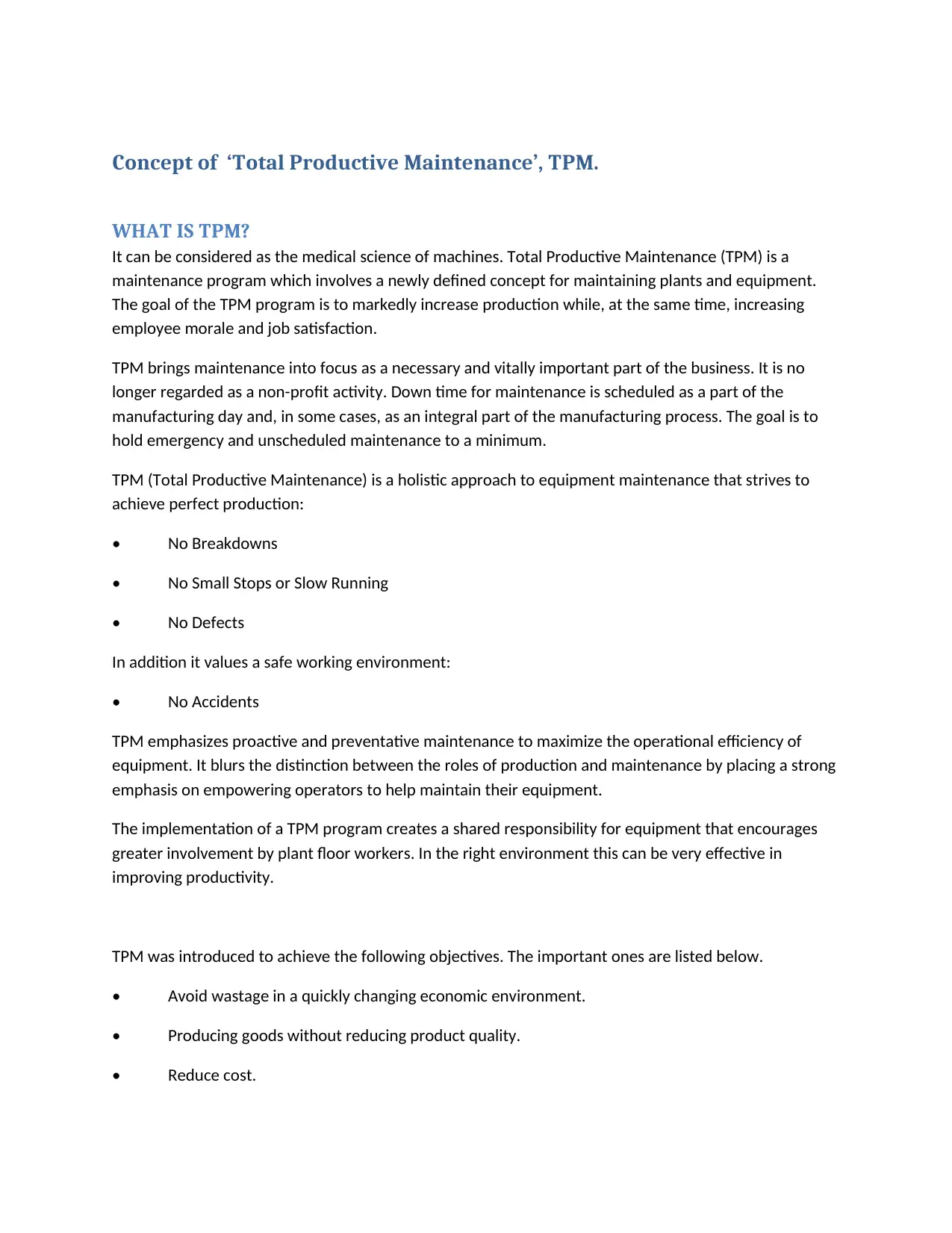
Concept of ‘Total Productive Maintenance’, TPM.
WHAT IS TPM?
It can be considered as the medical science of machines. Total Productive Maintenance (TPM) is a
maintenance program which involves a newly defined concept for maintaining plants and equipment.
The goal of the TPM program is to markedly increase production while, at the same time, increasing
employee morale and job satisfaction.
TPM brings maintenance into focus as a necessary and vitally important part of the business. It is no
longer regarded as a non-profit activity. Down time for maintenance is scheduled as a part of the
manufacturing day and, in some cases, as an integral part of the manufacturing process. The goal is to
hold emergency and unscheduled maintenance to a minimum.
TPM (Total Productive Maintenance) is a holistic approach to equipment maintenance that strives to
achieve perfect production:
• No Breakdowns
• No Small Stops or Slow Running
• No Defects
In addition it values a safe working environment:
• No Accidents
TPM emphasizes proactive and preventative maintenance to maximize the operational efficiency of
equipment. It blurs the distinction between the roles of production and maintenance by placing a strong
emphasis on empowering operators to help maintain their equipment.
The implementation of a TPM program creates a shared responsibility for equipment that encourages
greater involvement by plant floor workers. In the right environment this can be very effective in
improving productivity.
TPM was introduced to achieve the following objectives. The important ones are listed below.
• Avoid wastage in a quickly changing economic environment.
• Producing goods without reducing product quality.
• Reduce cost.
WHAT IS TPM?
It can be considered as the medical science of machines. Total Productive Maintenance (TPM) is a
maintenance program which involves a newly defined concept for maintaining plants and equipment.
The goal of the TPM program is to markedly increase production while, at the same time, increasing
employee morale and job satisfaction.
TPM brings maintenance into focus as a necessary and vitally important part of the business. It is no
longer regarded as a non-profit activity. Down time for maintenance is scheduled as a part of the
manufacturing day and, in some cases, as an integral part of the manufacturing process. The goal is to
hold emergency and unscheduled maintenance to a minimum.
TPM (Total Productive Maintenance) is a holistic approach to equipment maintenance that strives to
achieve perfect production:
• No Breakdowns
• No Small Stops or Slow Running
• No Defects
In addition it values a safe working environment:
• No Accidents
TPM emphasizes proactive and preventative maintenance to maximize the operational efficiency of
equipment. It blurs the distinction between the roles of production and maintenance by placing a strong
emphasis on empowering operators to help maintain their equipment.
The implementation of a TPM program creates a shared responsibility for equipment that encourages
greater involvement by plant floor workers. In the right environment this can be very effective in
improving productivity.
TPM was introduced to achieve the following objectives. The important ones are listed below.
• Avoid wastage in a quickly changing economic environment.
• Producing goods without reducing product quality.
• Reduce cost.
Paraphrase This Document
Need a fresh take? Get an instant paraphrase of this document with our AI Paraphraser
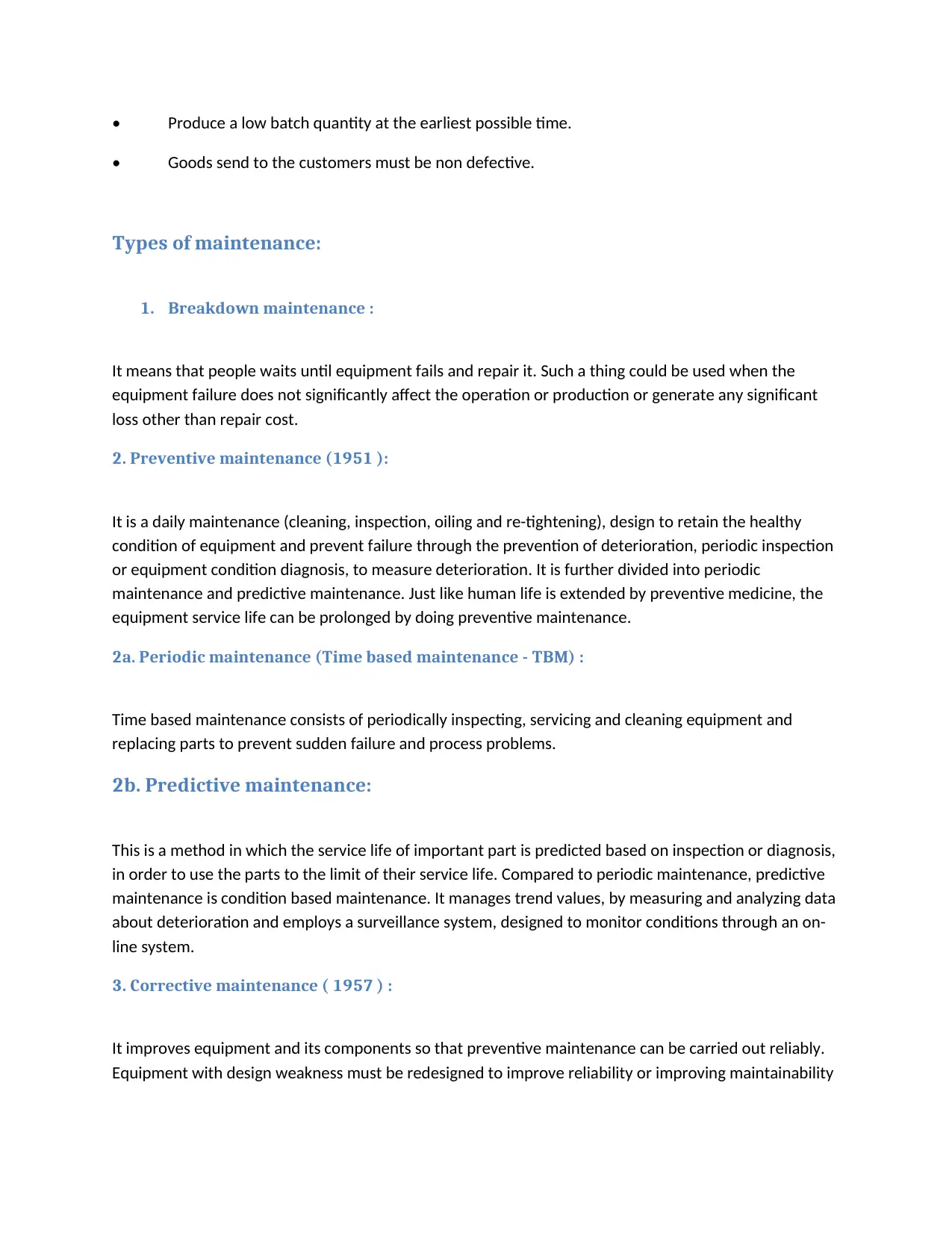
• Produce a low batch quantity at the earliest possible time.
• Goods send to the customers must be non defective.
Types of maintenance:
1. Breakdown maintenance :
It means that people waits until equipment fails and repair it. Such a thing could be used when the
equipment failure does not significantly affect the operation or production or generate any significant
loss other than repair cost.
2. Preventive maintenance (1951 ):
It is a daily maintenance (cleaning, inspection, oiling and re-tightening), design to retain the healthy
condition of equipment and prevent failure through the prevention of deterioration, periodic inspection
or equipment condition diagnosis, to measure deterioration. It is further divided into periodic
maintenance and predictive maintenance. Just like human life is extended by preventive medicine, the
equipment service life can be prolonged by doing preventive maintenance.
2a. Periodic maintenance (Time based maintenance - TBM) :
Time based maintenance consists of periodically inspecting, servicing and cleaning equipment and
replacing parts to prevent sudden failure and process problems.
2b. Predictive maintenance:
This is a method in which the service life of important part is predicted based on inspection or diagnosis,
in order to use the parts to the limit of their service life. Compared to periodic maintenance, predictive
maintenance is condition based maintenance. It manages trend values, by measuring and analyzing data
about deterioration and employs a surveillance system, designed to monitor conditions through an on-
line system.
3. Corrective maintenance ( 1957 ) :
It improves equipment and its components so that preventive maintenance can be carried out reliably.
Equipment with design weakness must be redesigned to improve reliability or improving maintainability
• Goods send to the customers must be non defective.
Types of maintenance:
1. Breakdown maintenance :
It means that people waits until equipment fails and repair it. Such a thing could be used when the
equipment failure does not significantly affect the operation or production or generate any significant
loss other than repair cost.
2. Preventive maintenance (1951 ):
It is a daily maintenance (cleaning, inspection, oiling and re-tightening), design to retain the healthy
condition of equipment and prevent failure through the prevention of deterioration, periodic inspection
or equipment condition diagnosis, to measure deterioration. It is further divided into periodic
maintenance and predictive maintenance. Just like human life is extended by preventive medicine, the
equipment service life can be prolonged by doing preventive maintenance.
2a. Periodic maintenance (Time based maintenance - TBM) :
Time based maintenance consists of periodically inspecting, servicing and cleaning equipment and
replacing parts to prevent sudden failure and process problems.
2b. Predictive maintenance:
This is a method in which the service life of important part is predicted based on inspection or diagnosis,
in order to use the parts to the limit of their service life. Compared to periodic maintenance, predictive
maintenance is condition based maintenance. It manages trend values, by measuring and analyzing data
about deterioration and employs a surveillance system, designed to monitor conditions through an on-
line system.
3. Corrective maintenance ( 1957 ) :
It improves equipment and its components so that preventive maintenance can be carried out reliably.
Equipment with design weakness must be redesigned to improve reliability or improving maintainability
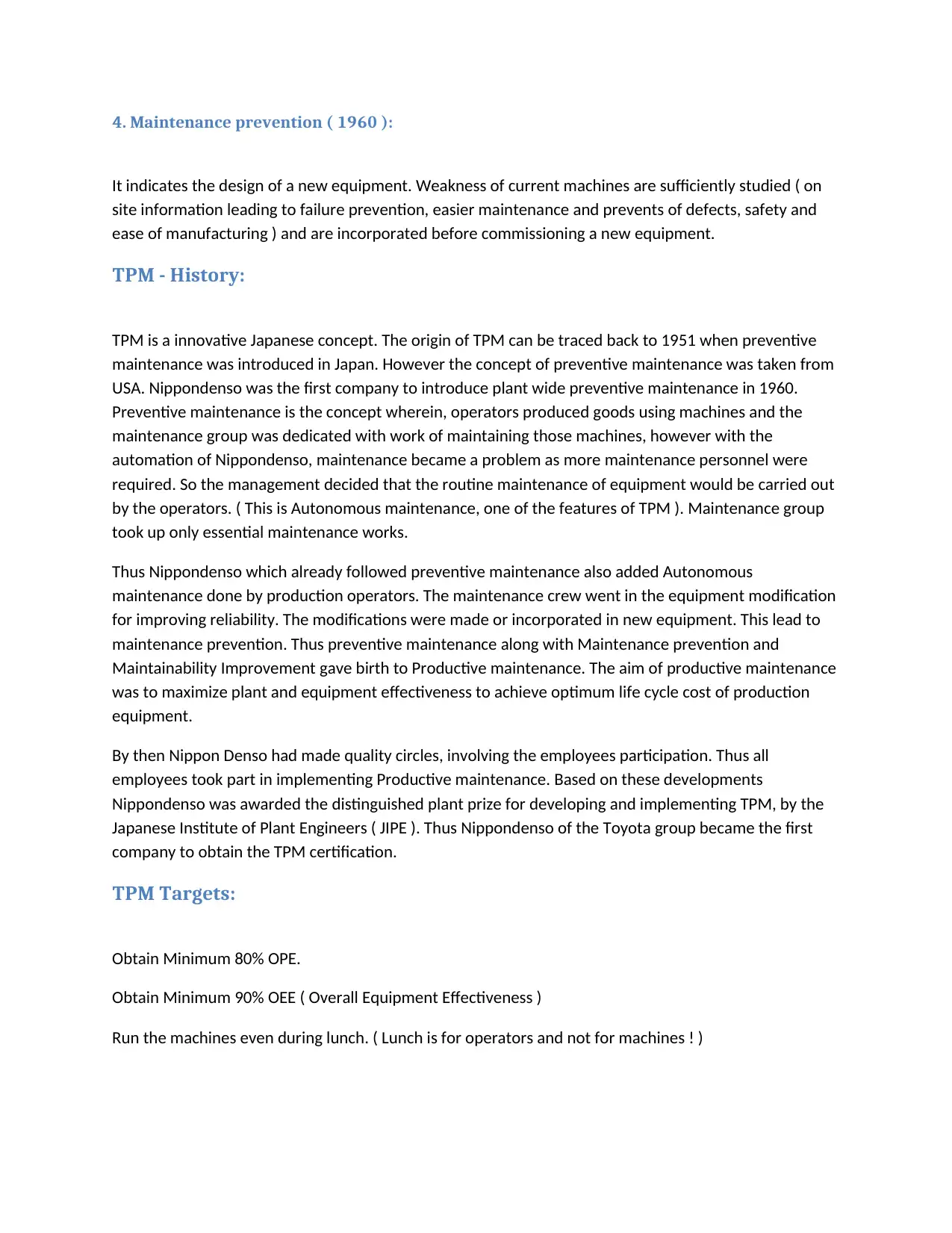
4. Maintenance prevention ( 1960 ):
It indicates the design of a new equipment. Weakness of current machines are sufficiently studied ( on
site information leading to failure prevention, easier maintenance and prevents of defects, safety and
ease of manufacturing ) and are incorporated before commissioning a new equipment.
TPM - History:
TPM is a innovative Japanese concept. The origin of TPM can be traced back to 1951 when preventive
maintenance was introduced in Japan. However the concept of preventive maintenance was taken from
USA. Nippondenso was the first company to introduce plant wide preventive maintenance in 1960.
Preventive maintenance is the concept wherein, operators produced goods using machines and the
maintenance group was dedicated with work of maintaining those machines, however with the
automation of Nippondenso, maintenance became a problem as more maintenance personnel were
required. So the management decided that the routine maintenance of equipment would be carried out
by the operators. ( This is Autonomous maintenance, one of the features of TPM ). Maintenance group
took up only essential maintenance works.
Thus Nippondenso which already followed preventive maintenance also added Autonomous
maintenance done by production operators. The maintenance crew went in the equipment modification
for improving reliability. The modifications were made or incorporated in new equipment. This lead to
maintenance prevention. Thus preventive maintenance along with Maintenance prevention and
Maintainability Improvement gave birth to Productive maintenance. The aim of productive maintenance
was to maximize plant and equipment effectiveness to achieve optimum life cycle cost of production
equipment.
By then Nippon Denso had made quality circles, involving the employees participation. Thus all
employees took part in implementing Productive maintenance. Based on these developments
Nippondenso was awarded the distinguished plant prize for developing and implementing TPM, by the
Japanese Institute of Plant Engineers ( JIPE ). Thus Nippondenso of the Toyota group became the first
company to obtain the TPM certification.
TPM Targets:
Obtain Minimum 80% OPE.
Obtain Minimum 90% OEE ( Overall Equipment Effectiveness )
Run the machines even during lunch. ( Lunch is for operators and not for machines ! )
It indicates the design of a new equipment. Weakness of current machines are sufficiently studied ( on
site information leading to failure prevention, easier maintenance and prevents of defects, safety and
ease of manufacturing ) and are incorporated before commissioning a new equipment.
TPM - History:
TPM is a innovative Japanese concept. The origin of TPM can be traced back to 1951 when preventive
maintenance was introduced in Japan. However the concept of preventive maintenance was taken from
USA. Nippondenso was the first company to introduce plant wide preventive maintenance in 1960.
Preventive maintenance is the concept wherein, operators produced goods using machines and the
maintenance group was dedicated with work of maintaining those machines, however with the
automation of Nippondenso, maintenance became a problem as more maintenance personnel were
required. So the management decided that the routine maintenance of equipment would be carried out
by the operators. ( This is Autonomous maintenance, one of the features of TPM ). Maintenance group
took up only essential maintenance works.
Thus Nippondenso which already followed preventive maintenance also added Autonomous
maintenance done by production operators. The maintenance crew went in the equipment modification
for improving reliability. The modifications were made or incorporated in new equipment. This lead to
maintenance prevention. Thus preventive maintenance along with Maintenance prevention and
Maintainability Improvement gave birth to Productive maintenance. The aim of productive maintenance
was to maximize plant and equipment effectiveness to achieve optimum life cycle cost of production
equipment.
By then Nippon Denso had made quality circles, involving the employees participation. Thus all
employees took part in implementing Productive maintenance. Based on these developments
Nippondenso was awarded the distinguished plant prize for developing and implementing TPM, by the
Japanese Institute of Plant Engineers ( JIPE ). Thus Nippondenso of the Toyota group became the first
company to obtain the TPM certification.
TPM Targets:
Obtain Minimum 80% OPE.
Obtain Minimum 90% OEE ( Overall Equipment Effectiveness )
Run the machines even during lunch. ( Lunch is for operators and not for machines ! )
⊘ This is a preview!⊘
Do you want full access?
Subscribe today to unlock all pages.

Trusted by 1+ million students worldwide
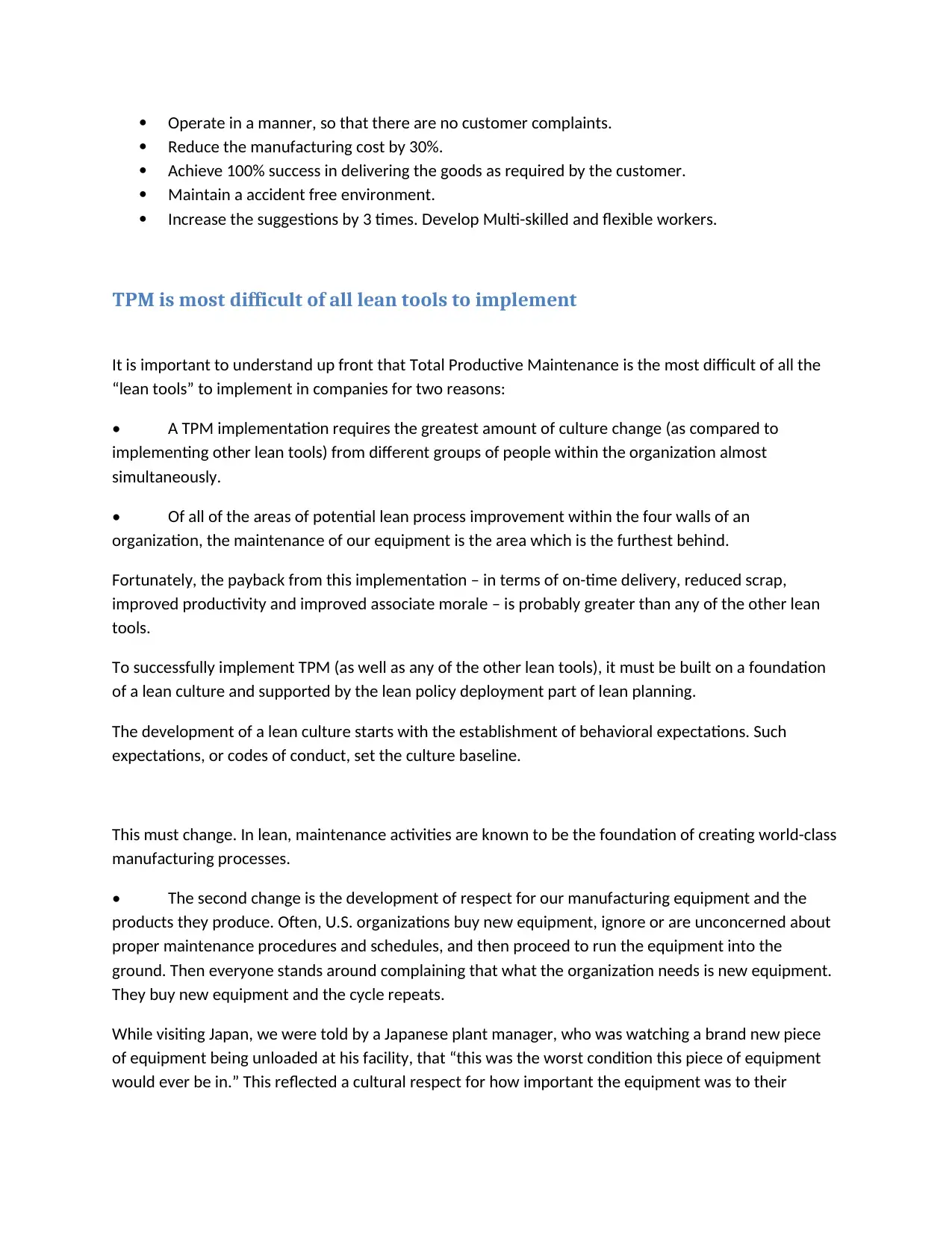
Operate in a manner, so that there are no customer complaints.
Reduce the manufacturing cost by 30%.
Achieve 100% success in delivering the goods as required by the customer.
Maintain a accident free environment.
Increase the suggestions by 3 times. Develop Multi-skilled and flexible workers.
TPM is most difficult of all lean tools to implement
It is important to understand up front that Total Productive Maintenance is the most difficult of all the
“lean tools” to implement in companies for two reasons:
• A TPM implementation requires the greatest amount of culture change (as compared to
implementing other lean tools) from different groups of people within the organization almost
simultaneously.
• Of all of the areas of potential lean process improvement within the four walls of an
organization, the maintenance of our equipment is the area which is the furthest behind.
Fortunately, the payback from this implementation – in terms of on-time delivery, reduced scrap,
improved productivity and improved associate morale – is probably greater than any of the other lean
tools.
To successfully implement TPM (as well as any of the other lean tools), it must be built on a foundation
of a lean culture and supported by the lean policy deployment part of lean planning.
The development of a lean culture starts with the establishment of behavioral expectations. Such
expectations, or codes of conduct, set the culture baseline.
This must change. In lean, maintenance activities are known to be the foundation of creating world-class
manufacturing processes.
• The second change is the development of respect for our manufacturing equipment and the
products they produce. Often, U.S. organizations buy new equipment, ignore or are unconcerned about
proper maintenance procedures and schedules, and then proceed to run the equipment into the
ground. Then everyone stands around complaining that what the organization needs is new equipment.
They buy new equipment and the cycle repeats.
While visiting Japan, we were told by a Japanese plant manager, who was watching a brand new piece
of equipment being unloaded at his facility, that “this was the worst condition this piece of equipment
would ever be in.” This reflected a cultural respect for how important the equipment was to their
Reduce the manufacturing cost by 30%.
Achieve 100% success in delivering the goods as required by the customer.
Maintain a accident free environment.
Increase the suggestions by 3 times. Develop Multi-skilled and flexible workers.
TPM is most difficult of all lean tools to implement
It is important to understand up front that Total Productive Maintenance is the most difficult of all the
“lean tools” to implement in companies for two reasons:
• A TPM implementation requires the greatest amount of culture change (as compared to
implementing other lean tools) from different groups of people within the organization almost
simultaneously.
• Of all of the areas of potential lean process improvement within the four walls of an
organization, the maintenance of our equipment is the area which is the furthest behind.
Fortunately, the payback from this implementation – in terms of on-time delivery, reduced scrap,
improved productivity and improved associate morale – is probably greater than any of the other lean
tools.
To successfully implement TPM (as well as any of the other lean tools), it must be built on a foundation
of a lean culture and supported by the lean policy deployment part of lean planning.
The development of a lean culture starts with the establishment of behavioral expectations. Such
expectations, or codes of conduct, set the culture baseline.
This must change. In lean, maintenance activities are known to be the foundation of creating world-class
manufacturing processes.
• The second change is the development of respect for our manufacturing equipment and the
products they produce. Often, U.S. organizations buy new equipment, ignore or are unconcerned about
proper maintenance procedures and schedules, and then proceed to run the equipment into the
ground. Then everyone stands around complaining that what the organization needs is new equipment.
They buy new equipment and the cycle repeats.
While visiting Japan, we were told by a Japanese plant manager, who was watching a brand new piece
of equipment being unloaded at his facility, that “this was the worst condition this piece of equipment
would ever be in.” This reflected a cultural respect for how important the equipment was to their
Paraphrase This Document
Need a fresh take? Get an instant paraphrase of this document with our AI Paraphraser
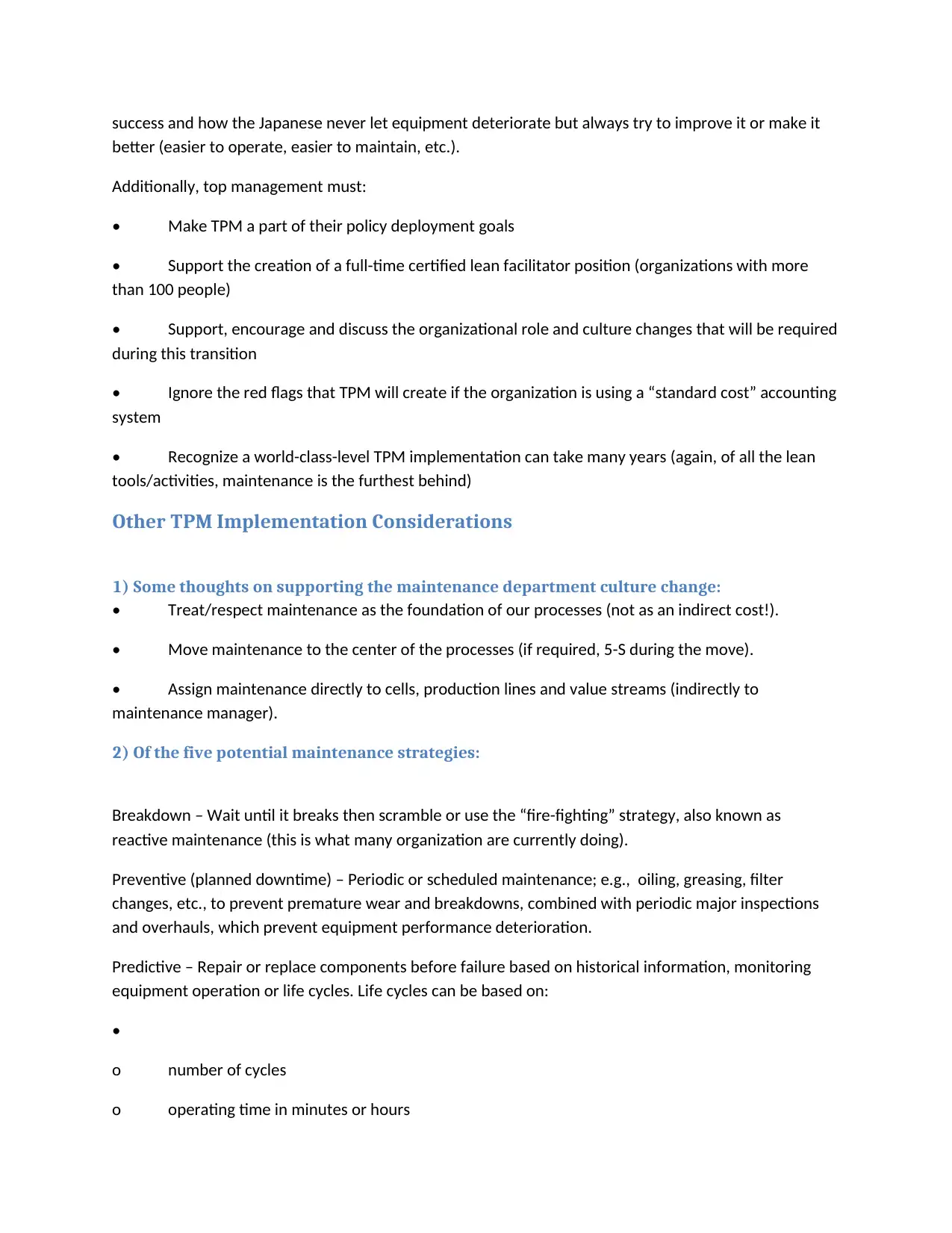
success and how the Japanese never let equipment deteriorate but always try to improve it or make it
better (easier to operate, easier to maintain, etc.).
Additionally, top management must:
• Make TPM a part of their policy deployment goals
• Support the creation of a full-time certified lean facilitator position (organizations with more
than 100 people)
• Support, encourage and discuss the organizational role and culture changes that will be required
during this transition
• Ignore the red flags that TPM will create if the organization is using a “standard cost” accounting
system
• Recognize a world-class-level TPM implementation can take many years (again, of all the lean
tools/activities, maintenance is the furthest behind)
Other TPM Implementation Considerations
1) Some thoughts on supporting the maintenance department culture change:
• Treat/respect maintenance as the foundation of our processes (not as an indirect cost!).
• Move maintenance to the center of the processes (if required, 5-S during the move).
• Assign maintenance directly to cells, production lines and value streams (indirectly to
maintenance manager).
2) Of the five potential maintenance strategies:
Breakdown – Wait until it breaks then scramble or use the “fire-fighting” strategy, also known as
reactive maintenance (this is what many organization are currently doing).
Preventive (planned downtime) – Periodic or scheduled maintenance; e.g., oiling, greasing, filter
changes, etc., to prevent premature wear and breakdowns, combined with periodic major inspections
and overhauls, which prevent equipment performance deterioration.
Predictive – Repair or replace components before failure based on historical information, monitoring
equipment operation or life cycles. Life cycles can be based on:
•
o number of cycles
o operating time in minutes or hours
better (easier to operate, easier to maintain, etc.).
Additionally, top management must:
• Make TPM a part of their policy deployment goals
• Support the creation of a full-time certified lean facilitator position (organizations with more
than 100 people)
• Support, encourage and discuss the organizational role and culture changes that will be required
during this transition
• Ignore the red flags that TPM will create if the organization is using a “standard cost” accounting
system
• Recognize a world-class-level TPM implementation can take many years (again, of all the lean
tools/activities, maintenance is the furthest behind)
Other TPM Implementation Considerations
1) Some thoughts on supporting the maintenance department culture change:
• Treat/respect maintenance as the foundation of our processes (not as an indirect cost!).
• Move maintenance to the center of the processes (if required, 5-S during the move).
• Assign maintenance directly to cells, production lines and value streams (indirectly to
maintenance manager).
2) Of the five potential maintenance strategies:
Breakdown – Wait until it breaks then scramble or use the “fire-fighting” strategy, also known as
reactive maintenance (this is what many organization are currently doing).
Preventive (planned downtime) – Periodic or scheduled maintenance; e.g., oiling, greasing, filter
changes, etc., to prevent premature wear and breakdowns, combined with periodic major inspections
and overhauls, which prevent equipment performance deterioration.
Predictive – Repair or replace components before failure based on historical information, monitoring
equipment operation or life cycles. Life cycles can be based on:
•
o number of cycles
o operating time in minutes or hours
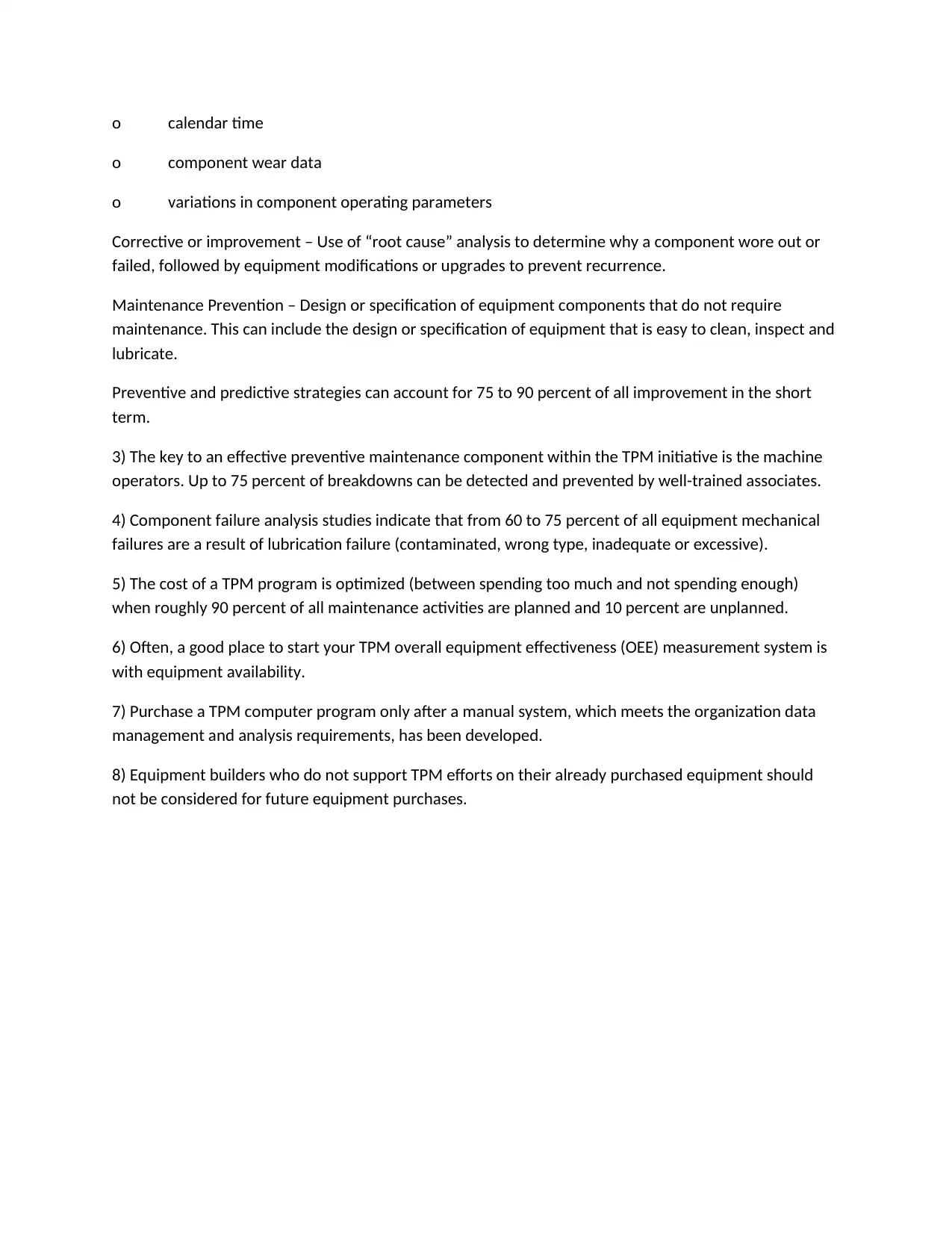
o calendar time
o component wear data
o variations in component operating parameters
Corrective or improvement – Use of “root cause” analysis to determine why a component wore out or
failed, followed by equipment modifications or upgrades to prevent recurrence.
Maintenance Prevention – Design or specification of equipment components that do not require
maintenance. This can include the design or specification of equipment that is easy to clean, inspect and
lubricate.
Preventive and predictive strategies can account for 75 to 90 percent of all improvement in the short
term.
3) The key to an effective preventive maintenance component within the TPM initiative is the machine
operators. Up to 75 percent of breakdowns can be detected and prevented by well-trained associates.
4) Component failure analysis studies indicate that from 60 to 75 percent of all equipment mechanical
failures are a result of lubrication failure (contaminated, wrong type, inadequate or excessive).
5) The cost of a TPM program is optimized (between spending too much and not spending enough)
when roughly 90 percent of all maintenance activities are planned and 10 percent are unplanned.
6) Often, a good place to start your TPM overall equipment effectiveness (OEE) measurement system is
with equipment availability.
7) Purchase a TPM computer program only after a manual system, which meets the organization data
management and analysis requirements, has been developed.
8) Equipment builders who do not support TPM efforts on their already purchased equipment should
not be considered for future equipment purchases.
o component wear data
o variations in component operating parameters
Corrective or improvement – Use of “root cause” analysis to determine why a component wore out or
failed, followed by equipment modifications or upgrades to prevent recurrence.
Maintenance Prevention – Design or specification of equipment components that do not require
maintenance. This can include the design or specification of equipment that is easy to clean, inspect and
lubricate.
Preventive and predictive strategies can account for 75 to 90 percent of all improvement in the short
term.
3) The key to an effective preventive maintenance component within the TPM initiative is the machine
operators. Up to 75 percent of breakdowns can be detected and prevented by well-trained associates.
4) Component failure analysis studies indicate that from 60 to 75 percent of all equipment mechanical
failures are a result of lubrication failure (contaminated, wrong type, inadequate or excessive).
5) The cost of a TPM program is optimized (between spending too much and not spending enough)
when roughly 90 percent of all maintenance activities are planned and 10 percent are unplanned.
6) Often, a good place to start your TPM overall equipment effectiveness (OEE) measurement system is
with equipment availability.
7) Purchase a TPM computer program only after a manual system, which meets the organization data
management and analysis requirements, has been developed.
8) Equipment builders who do not support TPM efforts on their already purchased equipment should
not be considered for future equipment purchases.
⊘ This is a preview!⊘
Do you want full access?
Subscribe today to unlock all pages.

Trusted by 1+ million students worldwide
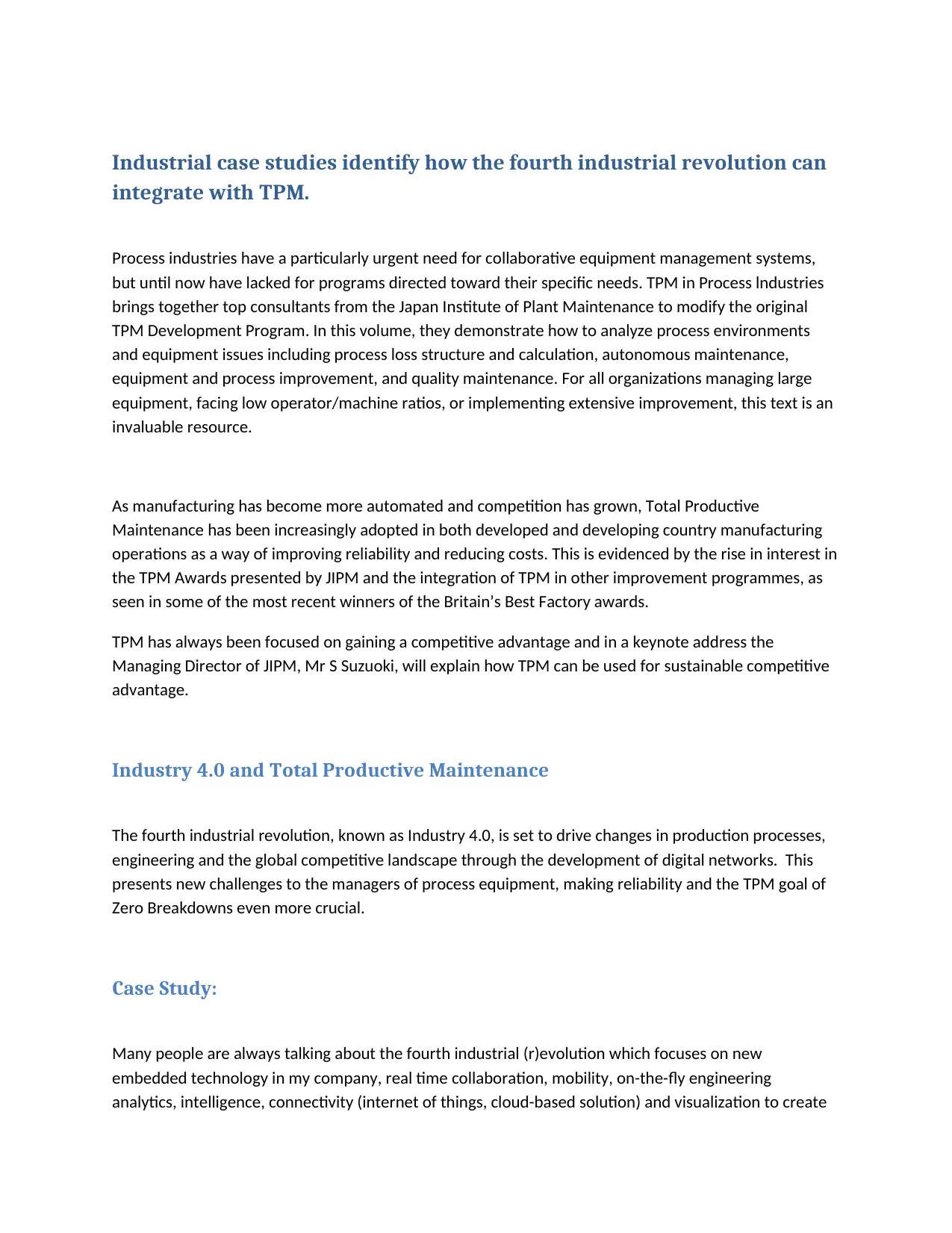
Industrial case studies identify how the fourth industrial revolution can
integrate with TPM.
Process industries have a particularly urgent need for collaborative equipment management systems,
but until now have lacked for programs directed toward their specific needs. TPM in Process lndustries
brings together top consultants from the Japan Institute of Plant Maintenance to modify the original
TPM Development Program. In this volume, they demonstrate how to analyze process environments
and equipment issues including process loss structure and calculation, autonomous maintenance,
equipment and process improvement, and quality maintenance. For all organizations managing large
equipment, facing low operator/machine ratios, or implementing extensive improvement, this text is an
invaluable resource.
As manufacturing has become more automated and competition has grown, Total Productive
Maintenance has been increasingly adopted in both developed and developing country manufacturing
operations as a way of improving reliability and reducing costs. This is evidenced by the rise in interest in
the TPM Awards presented by JIPM and the integration of TPM in other improvement programmes, as
seen in some of the most recent winners of the Britain’s Best Factory awards.
TPM has always been focused on gaining a competitive advantage and in a keynote address the
Managing Director of JIPM, Mr S Suzuoki, will explain how TPM can be used for sustainable competitive
advantage.
Industry 4.0 and Total Productive Maintenance
The fourth industrial revolution, known as Industry 4.0, is set to drive changes in production processes,
engineering and the global competitive landscape through the development of digital networks. This
presents new challenges to the managers of process equipment, making reliability and the TPM goal of
Zero Breakdowns even more crucial.
Case Study:
Many people are always talking about the fourth industrial (r)evolution which focuses on new
embedded technology in my company, real time collaboration, mobility, on-the-fly engineering
analytics, intelligence, connectivity (internet of things, cloud-based solution) and visualization to create
integrate with TPM.
Process industries have a particularly urgent need for collaborative equipment management systems,
but until now have lacked for programs directed toward their specific needs. TPM in Process lndustries
brings together top consultants from the Japan Institute of Plant Maintenance to modify the original
TPM Development Program. In this volume, they demonstrate how to analyze process environments
and equipment issues including process loss structure and calculation, autonomous maintenance,
equipment and process improvement, and quality maintenance. For all organizations managing large
equipment, facing low operator/machine ratios, or implementing extensive improvement, this text is an
invaluable resource.
As manufacturing has become more automated and competition has grown, Total Productive
Maintenance has been increasingly adopted in both developed and developing country manufacturing
operations as a way of improving reliability and reducing costs. This is evidenced by the rise in interest in
the TPM Awards presented by JIPM and the integration of TPM in other improvement programmes, as
seen in some of the most recent winners of the Britain’s Best Factory awards.
TPM has always been focused on gaining a competitive advantage and in a keynote address the
Managing Director of JIPM, Mr S Suzuoki, will explain how TPM can be used for sustainable competitive
advantage.
Industry 4.0 and Total Productive Maintenance
The fourth industrial revolution, known as Industry 4.0, is set to drive changes in production processes,
engineering and the global competitive landscape through the development of digital networks. This
presents new challenges to the managers of process equipment, making reliability and the TPM goal of
Zero Breakdowns even more crucial.
Case Study:
Many people are always talking about the fourth industrial (r)evolution which focuses on new
embedded technology in my company, real time collaboration, mobility, on-the-fly engineering
analytics, intelligence, connectivity (internet of things, cloud-based solution) and visualization to create
Paraphrase This Document
Need a fresh take? Get an instant paraphrase of this document with our AI Paraphraser
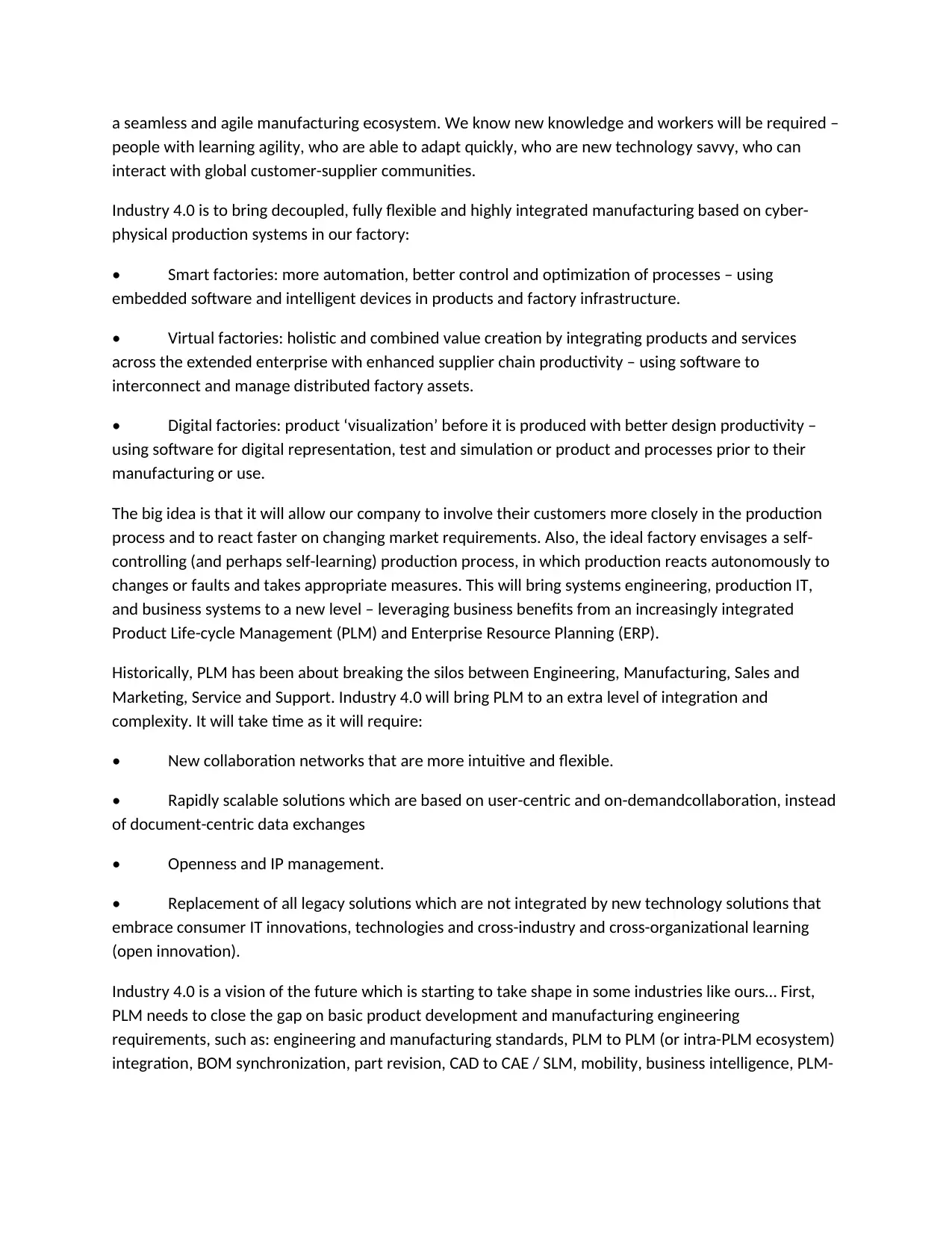
a seamless and agile manufacturing ecosystem. We know new knowledge and workers will be required –
people with learning agility, who are able to adapt quickly, who are new technology savvy, who can
interact with global customer-supplier communities.
Industry 4.0 is to bring decoupled, fully flexible and highly integrated manufacturing based on cyber-
physical production systems in our factory:
• Smart factories: more automation, better control and optimization of processes – using
embedded software and intelligent devices in products and factory infrastructure.
• Virtual factories: holistic and combined value creation by integrating products and services
across the extended enterprise with enhanced supplier chain productivity – using software to
interconnect and manage distributed factory assets.
• Digital factories: product ‘visualization’ before it is produced with better design productivity –
using software for digital representation, test and simulation or product and processes prior to their
manufacturing or use.
The big idea is that it will allow our company to involve their customers more closely in the production
process and to react faster on changing market requirements. Also, the ideal factory envisages a self-
controlling (and perhaps self-learning) production process, in which production reacts autonomously to
changes or faults and takes appropriate measures. This will bring systems engineering, production IT,
and business systems to a new level – leveraging business benefits from an increasingly integrated
Product Life-cycle Management (PLM) and Enterprise Resource Planning (ERP).
Historically, PLM has been about breaking the silos between Engineering, Manufacturing, Sales and
Marketing, Service and Support. Industry 4.0 will bring PLM to an extra level of integration and
complexity. It will take time as it will require:
• New collaboration networks that are more intuitive and flexible.
• Rapidly scalable solutions which are based on user-centric and on-demandcollaboration, instead
of document-centric data exchanges
• Openness and IP management.
• Replacement of all legacy solutions which are not integrated by new technology solutions that
embrace consumer IT innovations, technologies and cross-industry and cross-organizational learning
(open innovation).
Industry 4.0 is a vision of the future which is starting to take shape in some industries like ours… First,
PLM needs to close the gap on basic product development and manufacturing engineering
requirements, such as: engineering and manufacturing standards, PLM to PLM (or intra-PLM ecosystem)
integration, BOM synchronization, part revision, CAD to CAE / SLM, mobility, business intelligence, PLM-
people with learning agility, who are able to adapt quickly, who are new technology savvy, who can
interact with global customer-supplier communities.
Industry 4.0 is to bring decoupled, fully flexible and highly integrated manufacturing based on cyber-
physical production systems in our factory:
• Smart factories: more automation, better control and optimization of processes – using
embedded software and intelligent devices in products and factory infrastructure.
• Virtual factories: holistic and combined value creation by integrating products and services
across the extended enterprise with enhanced supplier chain productivity – using software to
interconnect and manage distributed factory assets.
• Digital factories: product ‘visualization’ before it is produced with better design productivity –
using software for digital representation, test and simulation or product and processes prior to their
manufacturing or use.
The big idea is that it will allow our company to involve their customers more closely in the production
process and to react faster on changing market requirements. Also, the ideal factory envisages a self-
controlling (and perhaps self-learning) production process, in which production reacts autonomously to
changes or faults and takes appropriate measures. This will bring systems engineering, production IT,
and business systems to a new level – leveraging business benefits from an increasingly integrated
Product Life-cycle Management (PLM) and Enterprise Resource Planning (ERP).
Historically, PLM has been about breaking the silos between Engineering, Manufacturing, Sales and
Marketing, Service and Support. Industry 4.0 will bring PLM to an extra level of integration and
complexity. It will take time as it will require:
• New collaboration networks that are more intuitive and flexible.
• Rapidly scalable solutions which are based on user-centric and on-demandcollaboration, instead
of document-centric data exchanges
• Openness and IP management.
• Replacement of all legacy solutions which are not integrated by new technology solutions that
embrace consumer IT innovations, technologies and cross-industry and cross-organizational learning
(open innovation).
Industry 4.0 is a vision of the future which is starting to take shape in some industries like ours… First,
PLM needs to close the gap on basic product development and manufacturing engineering
requirements, such as: engineering and manufacturing standards, PLM to PLM (or intra-PLM ecosystem)
integration, BOM synchronization, part revision, CAD to CAE / SLM, mobility, business intelligence, PLM-
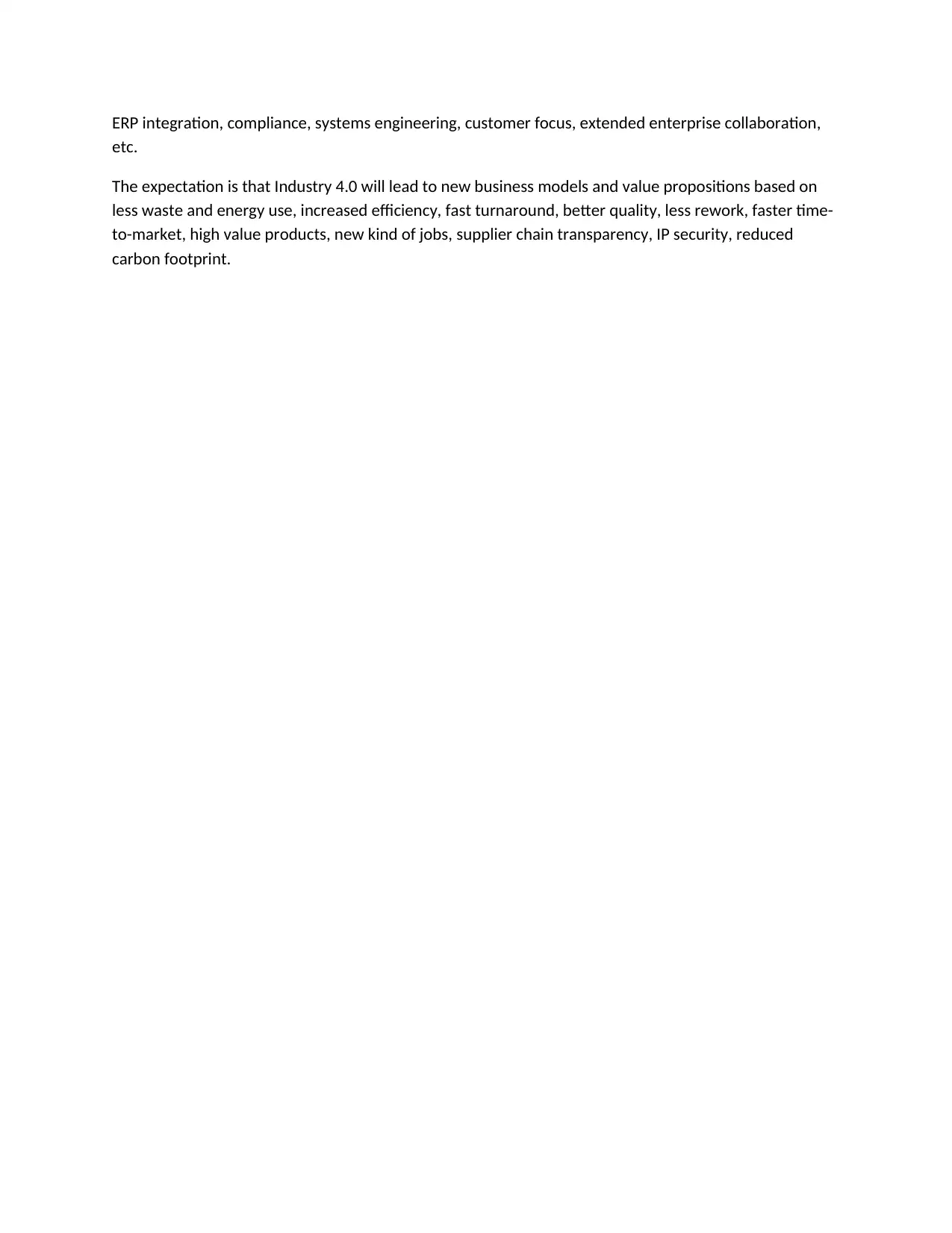
ERP integration, compliance, systems engineering, customer focus, extended enterprise collaboration,
etc.
The expectation is that Industry 4.0 will lead to new business models and value propositions based on
less waste and energy use, increased efficiency, fast turnaround, better quality, less rework, faster time-
to-market, high value products, new kind of jobs, supplier chain transparency, IP security, reduced
carbon footprint.
etc.
The expectation is that Industry 4.0 will lead to new business models and value propositions based on
less waste and energy use, increased efficiency, fast turnaround, better quality, less rework, faster time-
to-market, high value products, new kind of jobs, supplier chain transparency, IP security, reduced
carbon footprint.
⊘ This is a preview!⊘
Do you want full access?
Subscribe today to unlock all pages.

Trusted by 1+ million students worldwide
1 out of 25
Related Documents
Your All-in-One AI-Powered Toolkit for Academic Success.
+13062052269
info@desklib.com
Available 24*7 on WhatsApp / Email
![[object Object]](/_next/static/media/star-bottom.7253800d.svg)
Unlock your academic potential
Copyright © 2020–2025 A2Z Services. All Rights Reserved. Developed and managed by ZUCOL.




